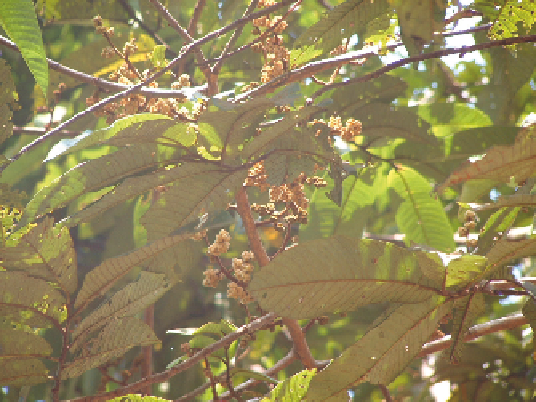Agriculture Reference
In-Depth Information
PYCNANTHUS ANGOLENSIS
Botanical Name —
Pycnanthus angolensis
Welw.
Synonym —
P. combo
Wa rb.
Family —
Myristicaceae
Common Names —
False nutmeg tree, African nutmeg, wild nutmeg
African Names —
Abe: walele; Bakwari (Duala, Bosamba, Nasamba, Bakoosi): ngosame;
Basa: dihin; Bini: moghan; Efik: abakang; Ibibio: abakang; Fanti: edua; Igbo: egwu-noma, egiri
oma; Mende: gboyei; Nupe: kpokogi; Nzima: tika; Timme: pompon; Yoruba: akomu
Description —
Pycnanthus angolensis
is a tall tree, up to 33 m high and about 3 m in girth. The
bole is long and straight, cylindrical and without buttress roots. The bark is reddish gray, scaly, and
fissured lengthwise. In old trees, the bark flakes off in patches. The slash is reddish and exudes a
sticky, honey-colored latex that turns red later. The branches are in two whorls; the twigs and leaves
are covered with rust-colored, woolly hairs. The leaves are leathery in texture, with a smooth upper
surface; the lower surface is covered with rust-colored hairs, which disappear with age; they are
generally riddled with holes caused by insects and are simple, 15-21 cm long and 5-9 cm broad,
with nearly parallel margins. They have a short apex and short and heart-shaped base. The midrib
is very prominent on the lower surface. The stalk is thick and about 1.5 cm long. The flowers are
small, brownish red, in small crowded heads, falling in masses around the base of the tree; male
and female are borne at different times; there are irregularly branched common stalks, which may
be as long as 7-15 cm. The flower stalks are among the leaves or slightly below them. The fruits
are egg shaped or almost round, 2-3 cm long and 1.5-2 cm in diameter. The shells are rather hard
and split longitudinally into two valves, exposing solitary seeds with bright red arils, which turn
brownish with time.
77
Habitat and Distribution —
Pycnanthus angolensis
is a lowland rainforest tree common in
secondary forests. It is distributed throughout the West Coast, Chad, Ethiopia, and parts of Somalia,
Zambia, and Zaire.
Ethnomedicinal Uses —
The seeds are aromatic and are used as a soup condiment in many parts
of Africa. The seed fat is applied together with the reddish latex on skin diseases. The bark is pounded
and drunk with palm wine for loss of appetite. The twigs are sucked to cure sores in the mouth.
77
The
root infusion is used with extracts of
Cassia occidentalis
and guinea grains as an anthelmintic.
9
In
Nigeria, the seeds are used for the preparation of mouthwash for the treatment of thrush.

